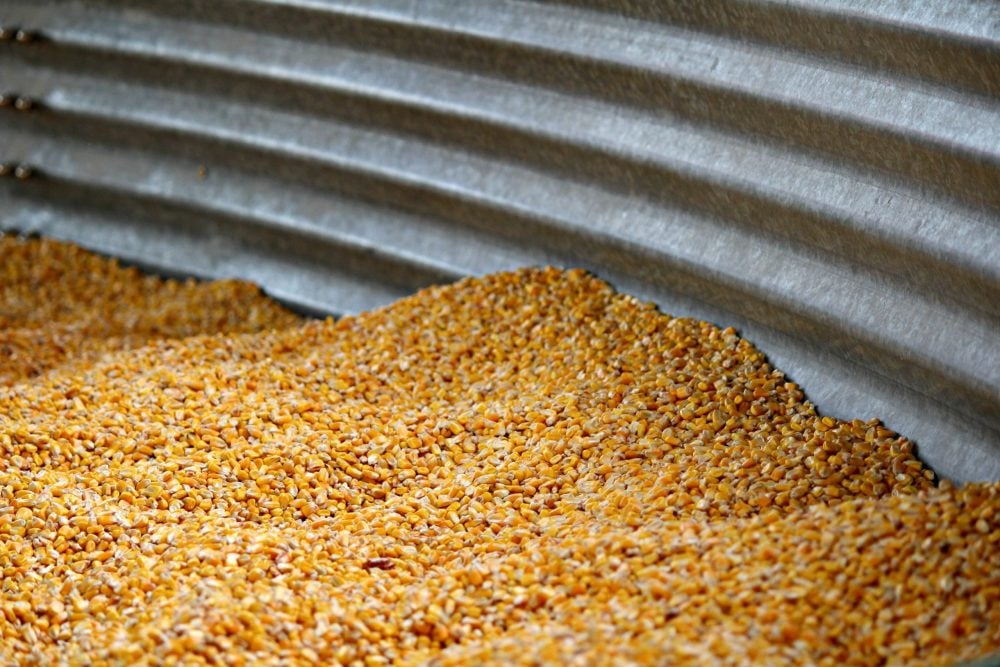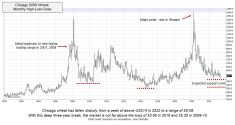Two main factors are influencing Ontario corn and soybean prices. First, the futures markets are incorporating a risk premium due to uncertainty in South American production. Drier conditions in Argentina have lowered crop prospects for the row crops.
Harvest is in the early stages in Brazil and yields are disappointing. We expect to see lower production estimates over the next month.
Quick look
Soybeans: A lower carryout for the 2021/22 crop year is expected due to an anticipated increase in the U.S. domestic crush and export demand.
Corn: Prices should rally once again in the spring by roughly $1/bu, as it did last year.
Wheat: Prices are relatively unchanged due to lower demand and export movement.
Read Also

Cycle swings dictate farming profitability
It can be profitable to understand where the crop markets are positioned in the context of their big-picture cycles.
Secondly, U.S. fundamentals for corn and soybeans will be tighter than earlier anticipated. Lower production estimates from South America will result in larger corn and soybean exports from the U.S. The corn ethanol grind continues to come in higher than expected and higher energy prices are underpinning the corn market. Stronger soymeal and soyoil demand will keep the U.S. domestic crush at higher levels.
Compared to earlier in January, Ontario winter wheat prices are relatively unchanged. Major importers and domestic millers are well covered for nearby needs. Aggressive prices from Russia, Ukraine and Romania have dominated Egyptian tenders.
Australia continues to saturate demand from Southeast Asia and Argentine wheat has a natural home in South America. Canadian and U.S. wheat offers are premium to world values, tempering export movement.
The Canadian dollar has been under pressure over the past month. Weaker economic data through the COVID-19 Omicron variant was justification for the Bank of Canada to keep its benchmark rate unchanged at its January meeting. January GDP data will be rather soft but a strong economic outlook is in the forecast for February and March.
Crude oil futures are poised to move up to $110 per barrel. Equity markets have a seasonal tendency to rally in the first quarter. There are many catalysts that point to a stronger Canadian dollar. The Baltic Dry Index is down to pre-pandemic levels. Ocean freight rates for bulk movement are under pressure and this may be the first crack in inflationary pressures.
Soybeans
Compared to earlier in January, Ontario soybean prices are up by more than $1/bushel. At the time of writing this article, elevator bids were hovering around $19.25/bu. while posted crusher prices were at $20/bu.
Brazilian soybean offers are about a US$10/tonne premium to U.S. soybeans out of the Gulf. Ontario soybean offers out of the St. Lawrence are at a US$8/tonne premium to U.S. soybeans.
It’s also important to remember that vessels usually charge a premium to come into the St. Lawrence ports during winter due to ice conditions. This freight premium has Ontario soybeans equivalent to Brazil.
China continues to be an aggressive buyer of U.S. soybeans for both old and new crop positions. Ontario crusher bids are premium to world values in an effort to attract farmer selling away from export channels.
Brazilian soybeans saw record heat late in the growing season, resulting in lower yields. Brazilian soybean production is expected to finish in the range of 130-134 million tonnes, down from the January USDA estimate of 139 million tonnes and down from last year’s output of 138 million tonnes.
Argentine soybean production is now forecast to finish in the range of 40-42 million tonnes, which is down from the January USDA number of 46.5 and down from the year-ago crop size of 46.2 million tonnes.
U.S. soyoil export sales are running 17 per cent above year-ago levels and soymeal sales are up five per cent from last year. On upcoming USDA reports, we’re looking for an increase in the domestic soybean crush. We’re also expecting exports to be adjusted higher. This will result in a lower carryout for the 2021/22 crop year.
Current elevator bids in Ontario are equivalent to values in late May of 2021, which is when prices peaked last season. We’ll likely see an increase in U.S. soybean acres this spring and if favourable conditions materialize, prices will go down.
What to do: We’re 80 per cent sold on the 2021 production and advising farmers to move to 90 per cent sold. The final 10 per cent will be gambling stocks in case of a North American drought.
Corn
Elevator corn bids in Ontario have been percolating higher in the past month. Ethanol processors appear to be well covered for nearby requirements. Feedlot operators also have sufficient ownership for next month’s requirements. Exports have slowed with the lakes closed. This lethargic demand environment has limited the upside.
On the flip side, world corn values are trending upward. The weather forecast for Argentina calls for limited precipitation over the next two weeks. Temperatures will be above average.
In conclusion, it’s hot and dry. We’re hearing of ranges between 43 and 46 million tonnes. This is down from the January USDA estimate of 54 million tonnes and compares to last year’s crop size of 50.5 million tonnes. The exportable surplus will be down approximately six to eight million tonnes from earlier projections.
In Brazil, analysts have slashed the first crop corn to the range of 21-22 million tonnes, down from earlier estimates around 27 million tonnes and down from last year’s first crop of 26 million tonnes. The second crop planting was about 30 per cent complete as of Feb. 4. Total Brazilian corn production is now expected to come in at 110 million tonnes, down from the January USDA number of 115 million tonnes. Last year’s total output was 87 million tonnes.
The main point is that lower production estimates from Argentina and Brazil will result in a lower exportable surplus. This could add eight to 10 million tonnes to the export demand out of the U.S. If a buyer needs significant volume for March or April, the U.S. is the only outlet.
We’re also expecting the USDA to increase U.S. ethanol usage on upcoming World Agriculture Supply and Demand Estimates reports. This will result in a lower carryout for the 2021/22 crop year. Given the tighter stocks in the U.S., the market cannot afford a crop problem this spring. We’re also anticipating a marginal year-over-year decline in acres at the expense of soybeans. High fertilizer prices will also eliminate some corn acres to other crops.
What to do: We’ve advised farmers to be 70 per cent sold on their 2021 production. We’re waiting to sell the final 30 per cent. We expect the corn market to incorporate a risk premium in April. To reiterate from our previous issue, the corn market rallied more than $1/bu. last spring and we expect a similar price pattern this year.
Wheat
Ontario winter wheat prices are relatively unchanged from last month. Like corn, the Ontario wheat market is suffering from a lack of fresh demand. Canadian and U.S. flour millers have the bulk of their requirements covered through March. Export movement has slowed. Ontario wheat prices are premium to world values, which is a natural market tendency this year.
We’re forecasting Ontario wheat stocks to drop to historical low levels by the end of the crop year, so the wheat market in Ontario must trade at a premium to world prices to ration demand. Ontario wheat prices will move in tandem with the world market while maintaining a US$10-$12 premium over prices to major importers such as Egypt.
The wheat complex tends to experience a seasonal rally when the Northern Hemisphere crop comes out of dormancy. The U.S. Southern Plains are on the drier side but seasonal rains occur in April. France and Germany have received average to above average precipitation. Ukraine has also received above normal precipitation over the winter.
In Russia, the Volga District is on the drier side but the Southern District is similar to Ukraine conditions. In Canada, southern Alberta and southern Saskatchewan have received below normal precipitation. The drought in North Dakota is over with more than 150 per cent of normal precipitation over the past couple months.
At this stage, major exporters are in good shape with the exception of the U.S. Southern Plains. Kansas is the main producer so we must watch how seasonal rains develop during April. The wheat market will also be pulled higher by the corn or coarse grain rally in spring. Once the U.S. harvest starts in June, wheat will trend lower into the summer.
What to do: We’ve advised producers to be 70 per cent sold on their 2021 production. We’re planning to make our next sales recommendation in April. Don’t hold stocks into new crop positions. As it looks now, major exporters will replenish wheat stocks.













